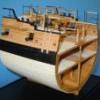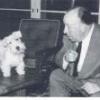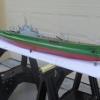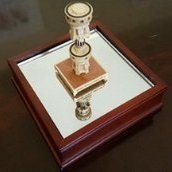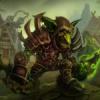Supplies of the Ship Modeler's Handbook are running out. Get your copy NOW before they are gone! Click on photo to order.
×
-
Posts
2,420 -
Joined
-
Last visited
Reputation Activity
-
 dvm27 reacted to Stuntflyer in HM Cutter Cheerful 1806 by Stuntflyer (Mike) - FINISHED - 1:48 scale
dvm27 reacted to Stuntflyer in HM Cutter Cheerful 1806 by Stuntflyer (Mike) - FINISHED - 1:48 scale
Well, its been an interesting week. The rope coils that were needed are now completed. I can see that this is an area that could use some further refinement and I will try to do that as the rigging continues. I tried to follow chuck's method of doing them, but came up a little short, I think. Also, I would like more rope available for re-tensioning should the need arise. In the end I came up with a different way that gives me a little more flexibility. Unfortunately, none of it can be used on the completed coils. Some of the photos are macro shots so the detail can be brutal. I referenced David Antscherls TFFM vol.4 pg 103 for making the rope coils.
The rope is wrapped around brass tubing of appropriate diameter. The pin makes space to pass the rope around the coil. A half hitch and a drop of glue secures things.
The original coils were done like this. The loop that goes over the belaying pin is one of the coil loops pulled up short and wrapped around the upper coil.
With the new technique the loose ends are cut off flush to the knot.
The way I did the completed rope coils can be seen on the left. The end of the rigging line was belayed, cut short and glued under the pin rail. The coil was then placed over the belaying pin. To demonstrate what I came up with afterwards I'll be using a free pin rail position on the right. Honestly though, I can't help but think that this has already been done. The rigging line is first belayed around the pin. Although not fully seen here, the blue painters tape was wedged behind the pin and pushed down to hold the rope while belaying. The free end is left long.
The rope coil was placed over the belaying pin with the knot behind the pin. It was then stretched with a 1/8" drill and given a coat of Badger "Clear Matte" acrylic.
This is the end result after removing the drill, hitching the loose end to the belaying pin and cutting the fall. Lots of rope to hold onto should the need to re-tension arise.
Mike
-
 dvm27 reacted to Tecko in Wardell Bridge and boat by Tecko - 1:72 - diorama
dvm27 reacted to Tecko in Wardell Bridge and boat by Tecko - 1:72 - diorama
Before building the span framework I decided to use mallet and chisel to entrench the wiring for both navigational lights and contacts.
Then added some of the framework so I could see where the wiring needs to go.
Then I got an idea for making the cable anchoring points on the span. I attached part of a fishing swivel to the small bolt heads. These will untwist any rotary tensions on the cables.
Just to see how it looks compared to my drawing.
It was about at this point I went around all the joints and added 3 mm dowels for added strength.
Below, I installing the wiring, tested all connections and made a map before covering it all up with wood putty.
to be continued... time to do some work.
-
 dvm27 reacted to KennyH78 in Raleigh 1777 by KennyH78 - Scale 1:96 - Continental Frigate - Hahn Plans
dvm27 reacted to KennyH78 in Raleigh 1777 by KennyH78 - Scale 1:96 - Continental Frigate - Hahn Plans
Another small update, but a huge milestone for me. The keel is finally laid, well sort of. It is actually mounted to the frames and hanging high in the clouds. I have also begun to add the rest of the frames; but that will be a slow process. I suspect that I will get about 3 frames installed in a day after work. The reason it takes so long is because the fore and aft faces of each frame need to be sanded smooth prior to installing them on the jig and keel.
I have also cut the pieces for the new blank for frame 2 and those are glued together and drying. Tomorrow I will glue another template to it and cut it our on the scroll saw and rough shape it and then install it on the keel.
-
 dvm27 reacted to Roger Pellett in Young America 1853 by EdT - FINISHED - extreme clipper
dvm27 reacted to Roger Pellett in Young America 1853 by EdT - FINISHED - extreme clipper
In the Crabtree collection at the Mariners Museum at Newport News, there is a model of a cave man polling or paddling a log raft. The guy is wearing an animal hide garment that according to the museum is a tanned mouse skin.
Roger
-
 dvm27 got a reaction from allanyed in Altair 1931 by KeithAug - FINISHED - Scale 1:32 - schooner
dvm27 got a reaction from allanyed in Altair 1931 by KeithAug - FINISHED - Scale 1:32 - schooner
"Precision eyeballing" - would be an oxymoron for me but pretty spot-on for your build. That's a gorgeous model.
-
 dvm27 reacted to KennyH78 in Raleigh 1777 by KennyH78 - Scale 1:96 - Continental Frigate - Hahn Plans
dvm27 reacted to KennyH78 in Raleigh 1777 by KennyH78 - Scale 1:96 - Continental Frigate - Hahn Plans
So for the last 3-4 days I have been making the saw fly. All of the square frames are now shaped to within 1/16" (give or take a little) of their final shape. I used a combination of the scroll saw, disc sander and a mini drum sander chucked into my bench top drill press to get them to this point. I have also installed frames 3, 25, and 47 into the frame jig. Once the glue is dry on those three frames, I will add the keel assymbly to it and start installing the rest of the square frames. The half and cant frames will be cut out and installed once the square frames are all installed. I also need to redo frame 2 since I totally missed that the bottom of the frame is not whole. The pictures can explain it better than I can.
So without further ado, here are the pictures as she sits now. As always, any and all comments are welcome.
-
 dvm27 got a reaction from JerseyCity Frankie in Young America 1853 by EdT - FINISHED - extreme clipper
dvm27 got a reaction from JerseyCity Frankie in Young America 1853 by EdT - FINISHED - extreme clipper
Sweet work it. I was surprised to see that the massive double stranded forestay starts and ends in two small thimbles and eye bolts. Wonder if they ever pulled out under stress?
-
 dvm27 got a reaction from Martin W in HM Sloop Fly by AnobiumPunctatum - 1:32 - POF
dvm27 got a reaction from Martin W in HM Sloop Fly by AnobiumPunctatum - 1:32 - POF
Well done, Christian. Doing this in two parts certainly helps keep the rabbet crisp but you did a very nice job..
-
 dvm27 got a reaction from Piet in Young America 1853 by EdT - FINISHED - extreme clipper
dvm27 got a reaction from Piet in Young America 1853 by EdT - FINISHED - extreme clipper
Sweet work it. I was surprised to see that the massive double stranded forestay starts and ends in two small thimbles and eye bolts. Wonder if they ever pulled out under stress?
-
 dvm27 got a reaction from Nirvana in HMS Pegasus 1776 by Trussben - 1:48 - Swan-class sloop based on TFFM
dvm27 got a reaction from Nirvana in HMS Pegasus 1776 by Trussben - 1:48 - Swan-class sloop based on TFFM
They're delicate little suckers. Ben. Same thing happened to me (and Toni, I believe). Second time around I glued on some battens to hopefully keep it stable until planking.
-
 dvm27 got a reaction from Eddie in HM Sloop Fly by AnobiumPunctatum - 1:32 - POF
dvm27 got a reaction from Eddie in HM Sloop Fly by AnobiumPunctatum - 1:32 - POF
I agree, Christian. The stern deadwood is more difficult and you have to match starboard and port sides prefectly, especially the positions of the steps. CNC would certainly make this easier!
-
 dvm27 got a reaction from Eddie in HM Sloop Fly by AnobiumPunctatum - 1:32 - POF
dvm27 got a reaction from Eddie in HM Sloop Fly by AnobiumPunctatum - 1:32 - POF
Outstanding, Christian. Looks like you've left well in excess of 3" on those steps.I can't tell from your photograph but the aft deadwood above the bearding line should taper to 10" at the stern deadwood.See TFFM 1.23.
-
 dvm27 got a reaction from Eddie in HM Sloop Fly by AnobiumPunctatum - 1:32 - POF
dvm27 got a reaction from Eddie in HM Sloop Fly by AnobiumPunctatum - 1:32 - POF
Your approach to the rising wood will help you immeasurably when it comes to raising the frames, Christian. Well done!
-
 dvm27 got a reaction from AnobiumPunctatum in HM Sloop Fly by AnobiumPunctatum - 1:32 - POF
dvm27 got a reaction from AnobiumPunctatum in HM Sloop Fly by AnobiumPunctatum - 1:32 - POF
Well done, Christian. Doing this in two parts certainly helps keep the rabbet crisp but you did a very nice job..
-
 dvm27 got a reaction from mtaylor in HM Sloop Fly by AnobiumPunctatum - 1:32 - POF
dvm27 got a reaction from mtaylor in HM Sloop Fly by AnobiumPunctatum - 1:32 - POF
Well done, Christian. Doing this in two parts certainly helps keep the rabbet crisp but you did a very nice job..
-
 dvm27 got a reaction from Martin W in HMS Pegasus 1776 by Trussben - 1:48 - Swan-class sloop based on TFFM
dvm27 got a reaction from Martin W in HMS Pegasus 1776 by Trussben - 1:48 - Swan-class sloop based on TFFM
They're delicate little suckers. Ben. Same thing happened to me (and Toni, I believe). Second time around I glued on some battens to hopefully keep it stable until planking.
-
 dvm27 reacted to Dan Vadas in Concord Stagecoach by Dan Vadas - FINISHED - Model Trailways - 1:12 scale - circa 1862 "Cobb & Co"
dvm27 reacted to Dan Vadas in Concord Stagecoach by Dan Vadas - FINISHED - Model Trailways - 1:12 scale - circa 1862 "Cobb & Co"
A pretty good day's work - I've completed all the Running Gear on which the front axle is attached :
This is how the assembly will fit relative to the frame :
Cheers, Danny
-
 dvm27 reacted to Maury S in Anchor Hoy c. 1825 by Maury S - FINISHED - 1:48 - Harbor craft - POF
dvm27 reacted to Maury S in Anchor Hoy c. 1825 by Maury S - FINISHED - 1:48 - Harbor craft - POF
The stanchions and bottoms of the rails are painted and the rails are test fitted.
And more from the side...
The tops of the stanchion tenons are clipped and sanded off and the stanchions are glued in place.
Maury
-
 dvm27 got a reaction from mtaylor in HMS Pegasus 1776 by Trussben - 1:48 - Swan-class sloop based on TFFM
dvm27 got a reaction from mtaylor in HMS Pegasus 1776 by Trussben - 1:48 - Swan-class sloop based on TFFM
They're delicate little suckers. Ben. Same thing happened to me (and Toni, I believe). Second time around I glued on some battens to hopefully keep it stable until planking.
-
 dvm27 reacted to marsalv in Pandora by marsalv - FINISHED - 1:52
dvm27 reacted to marsalv in Pandora by marsalv - FINISHED - 1:52
Thank you very much guys.
Denis - the red frame in front of the stove is called riding bitts. Citation from the Peter Goodwin´s book The Construction and Fitting of English Man of War:
These large timbers acted as securing point for cables which held the ship while riding at anchor. And why is the stove so close to the riding bitts - I have no idea.
Some new parts - ladders.
-
 dvm27 reacted to shipmodel in SS Michelangelo 1962 by shipmodel - FINISHED - 1/350 scale
dvm27 reacted to shipmodel in SS Michelangelo 1962 by shipmodel - FINISHED - 1/350 scale
Hi all –
Thanks for the conversations and the likes, as always. And thanks for looking in on my little diversion. It was an exercise in water sculpture, and reasonably successful, although I have a ways to go to make it that spray truly realistic.
When the last installment ended, the hull had been glued up and shaped. The wood had been hardened, ready for final finishing.
The next step was to bring the hull to a smooth surface, ready for the color coats. I first filled the pores of the wood with a slurry of plaster of paris. Here it is shortly after being painted on
.
Before it dried and became opaque I laid in a 1/16” wide strip of tape along the waterline as I did here on the Doria model.
With the plaster dry it was gently sanded with a medium grit sanding sponge to smooth and fair the planes and surfaces. Here is how it looked at the bow. The waterline tape was removed at this point, but it left a very shallow but indelible depression along the length of the hull that will guide my painting later on.
What followed were many refinements to those hull planes and surfaces, done with multiple layers of spray primer. The first several were of grey, sandable primer which filled in the deepest of the sanding scratches. For preference I use Krylon in the rattle can. It is fast-drying and builds up a sufficiently thick layer with only a few coats. But it is getting harder to find. Even Amazon runs out from time to time. I have found that the comparable product from Ace Hardware is almost identical.
Medium and fine grit sanding sponges smoothed out the grey primer, then coats of white primer were sprayed on. This is a much different formulation, not just the color. It goes on thinner and dries to a much harder surface. Finer and finer grits of sandpaper were used, ending with a rubdown with a plastic scouring pad to burnish the surface. Much will be done to the hull, and it will get carved, drilled and sections ground out, but it was nice to have a smooth canvas to work on.
The first addition to the hull was the bulwark at the bow. This has to be flared considerably to match the steep angle of the hull at the nose. To get this shape, I wrapped a wide strip of card stock around the bow and taped it in place, making sure that it lay tight and flat all around the bow. Where it rose above the deck, I penciled in a line. Using a flat piece of scrap as a spacer, a second line was drawn at the height of the finished bulwark. The card was removed and a third line was drawn, freehand, about ¼” below the deck line to account for where it will be attached to the hull. Several were made and discarded before one was acceptable. The finished template shape looked like this.
This shape was cut out of a piece of 0.020” styrene sheet. I made sure to make the first cuts overlarge, then it was slowly refined by repeatedly offering it up to the desired location and trimming as needed. A shallow step was cut, carved, and ground into the hull and the piece laid in and secured with gel superglue. The edges were filled and faired with Squadron white putty. Here is the bow bulwark piece before final fairing into the hull. The difference in sheen tells me where the putty still needs more refining. The bulwark is still a bit oversize at the top edge, which will not be refined until the detailing process begins.
This was my first time using Squadron putty. It is a solvent based gel which comes in a tube like toothpaste and is squeezed out in much the same way. Because it is solvent based it dries quickly, but the fumes are a bit harsh, so have some good ventilation where you work with it. The other problem is that it shrinks substantially as it dries. Some deep depressions had to have several layers applied before it built up enough to sand back to a smooth surface.
Next, I work on the stern.
Be well
Dan
-
 dvm27 got a reaction from mtaylor in Young America 1853 by EdT - FINISHED - extreme clipper
dvm27 got a reaction from mtaylor in Young America 1853 by EdT - FINISHED - extreme clipper
Sweet work it. I was surprised to see that the massive double stranded forestay starts and ends in two small thimbles and eye bolts. Wonder if they ever pulled out under stress?
-
 dvm27 got a reaction from Canute in HMS Pegasus 1776 by Trussben - 1:48 - Swan-class sloop based on TFFM
dvm27 got a reaction from Canute in HMS Pegasus 1776 by Trussben - 1:48 - Swan-class sloop based on TFFM
They're delicate little suckers. Ben. Same thing happened to me (and Toni, I believe). Second time around I glued on some battens to hopefully keep it stable until planking.
-
 dvm27 reacted to Dan Vadas in Concord Stagecoach by Dan Vadas - FINISHED - Model Trailways - 1:12 scale - circa 1862 "Cobb & Co"
dvm27 reacted to Dan Vadas in Concord Stagecoach by Dan Vadas - FINISHED - Model Trailways - 1:12 scale - circa 1862 "Cobb & Co"
I've completed the Frame, or chassis.
Here are two pics of the Brace Header "iron" work, made from brass, silver soldered and blackened :
This is the assembly in place, complete with tiny square nuts and two 1.3mm threaded bolts and nuts :
The front and rear Standards are supported by struts, cast from Brittania metal. I've found most of these castings to be adequate without being exceptional. The metal itself is in very good condition, easily bent without snapping (except for 1 piece which was easily fixed). The casting was only so-so, with a fair bit of flash cleaning needed :
One step that the instructions omitted was to check the fit of the CNC lathe turned Wheel Hubs on the axles. This caused me considerable drama, as the axles were between 0.3mm and 0.7mm too large in diameter. Not too bad for the front axle, which was still unattached, but a lot harder to trim on the already-fitted rear axle. After using a flat needle file to correct the front axle I attempted the same on the rear. 10 minutes later I was still nowhere near doing one side, when I came up with the idea of shaving the axle with a #11 Xacto knife - brilliant . It took less than 5 minutes to complete BOTH sides.
The shavings shown in the pic below are from ONE side of the axle :
Here's where I am up to. BTW - the brake mechanism actually WORKS :
Cheers, Danny
-
 dvm27 reacted to Dan Vadas in Concord Stagecoach by Dan Vadas - FINISHED - Model Trailways - 1:12 scale - circa 1862 "Cobb & Co"
dvm27 reacted to Dan Vadas in Concord Stagecoach by Dan Vadas - FINISHED - Model Trailways - 1:12 scale - circa 1862 "Cobb & Co"
Thanks guys,
A fair amount of progress in the last few days. Bear in mind that while I may know a bit about building ships I know NOTHING about building stagecoaches, so progress is a bit slower than usual as I'm actually following the kit instructions . Fortunately the basic techniques of construction are pretty much the same.
Here's where I'm up to - the Frame assembled and waiting for glue to dry before installing the End Plates and nuts on the Draw Bolts :
Some detail of the rivets holding the Standards. The brass looks out of place, I'll do something with them a bit later. Note the U-bolt Clips, made from brass strip and silver-solder "bolts" which have been blackened :
The Draw Bolts which hold the whole thing together. I squared the heads of brass pins with a hammer and anvil. The nuts are kit supplied and laser cut from some kind of rubber/cardboard composite to simulate iron. As with the rest of the laser cut parts they are of excellent quality :
Cheers, Danny


